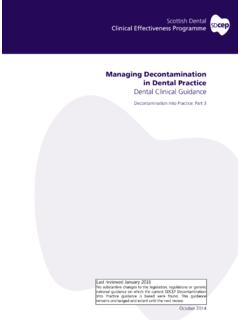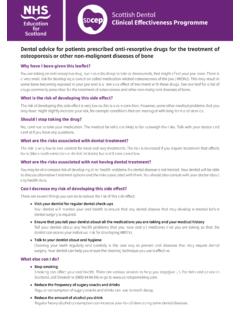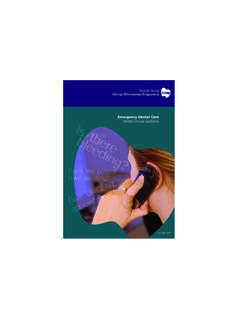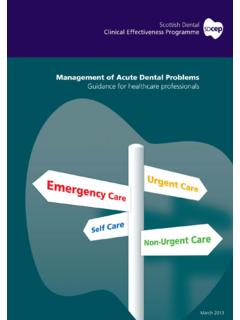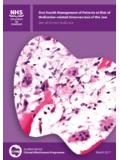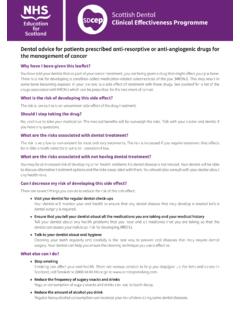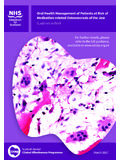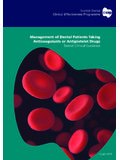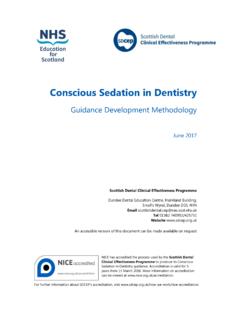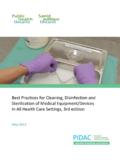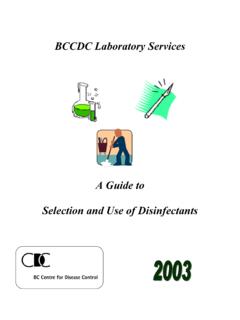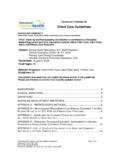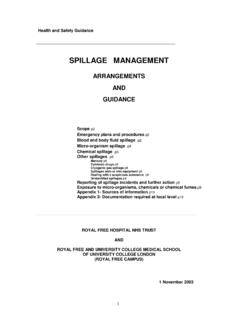Transcription of Dental Clinical Guidance - SDCEP
1 Sterilization of Dental InstrumentsDental Clinical GuidanceScottish DentalClinical Effectiveness ProgrammeSDcepDecember 2011 Scottish DentalClinical Effectiveness ProgrammeSDcepThe Scottish Dental Clinical Effectiveness Programme ( SDCEP ) is an initiative of the National Dental Advisory Committee (NDAC) and is supported by the Scottish Government and NHS Education for Scotland. The Programme aims to provide user-friendly, evidence-based Guidance for the Dental profession in Scotland. SDCEP Guidance is designed to help the Dental team provide improved care for patients by bringing together, in a structured manner, the best available information that is relevant to priority areas in dentistry, and presenting this information in a form that can be interpreted easily and implemented. Supporting the Dental team to provide quality patient care Scottish DentalClinical Effectiveness ProgrammeSDcepSterilization of Dental InstrumentsDental Clinical GuidanceDecontamination Into Practice: Part 2 December 2011 Scottish Dental Clinical Effectiveness ProgrammeSDCEP operates within NHS Education for Scotland.
2 You may copy or reproduce the information in this document for use within NHS Scotland and for non-commercial educational of this document for commercial purpose is permitted only with written 978 1 905829 14 9 First published December 2011 Scottish Dental Clinical Effectiveness ProgrammeDundee Dental Education Centre, Frankland Building, Small s Wynd, Dundee DD1 4 HNEmail 01382 425751 / 425771 Website of Dental Instruments1 Introduction 1 Sterilization in the Dental Practice 2 Sterilization Cycles in Small Steam Sterilizers 3 Sterilized versus Sterile 4 Sterilization of Dental Handpieces 52 Organising Sterilization Within the decontamination Area 6 Purchasing a Small Steam Sterilizer 6 The NHSS cotland National Contract for decontamination Equipment 7 Purchasing Reusable Instruments 8 Staff Roles 8 Staff Training 8 Sterilization Workflow 93 Important Factors in Effective Sterilization 10 Health & Safety Requirements for Small Steam Sterilizers 10 Installation and Validation of Small Steam Sterilizers 10 Testing and Maintenance of Small Steam Sterilizers 11 Cleanliness of Instruments 11 Loading of Instruments 11 Water for Use in Steam Sterilizers 12 Sterilizer
3 Logbook and Record Keeping 124 Sterilization Procedure 13 General Operation of Steam Sterilizers 13 Before Sterilization 13 After Sterilization 14 At the End of the Day 14 Unwrapped Instruments (All Sterilizers) 14 Handling and Storage of Unwrapped Instruments Immediately After Sterilization 15 Wrapped Instruments (Vacuum Sterilizers) 16 Handling and Storage of Wrapped Instruments Immediately After Sterilization 175 Inspection of Instrument Packs Before Use 186 Validation, Periodic Testing and Maintenance of Small Steam Sterilizers 19 Housekeeping and Safety Checks 20 Daily Housekeeping Checks for All Sterilizers 20 Weekly Safety Checks for All Sterilizers 20 Automatic Control Test for All Sterilizers 20 Automatic Control Test Using a Recorder 21 Manual Automatic Control Test 21 Steam Penetration Test for Vacuum Sterilizers 22 Air Leakage Test for Vacuum Sterilizers 22 Automatic Air Detection System Function Test for Vacuum Sterilizers 23 Other Periodic Tests 23 Maintenance of Small Steam Sterilizers 23 Sterilization of Dental InstrumentsiiiSterilization of Dental Instrumentsiv1 decontamination Into Practice is part of a national initiative to promote and standardise good decontamination practice in Dental primary 1, Cleaning of Dental Instruments (published in 2007)
4 Deals with how to clean Dental instruments thoroughly, including thermal disinfection using a washer-disinfector, and advice about rinsing, drying and inspection of the instruments after cleaning. Part 2, Sterilization of Dental Instruments focuses on how to sterilize Dental instruments after cleaning, using small steam sterilizers. It provides advice that is based on health and safety regulations and current technical Guidance on sterilization within healthcare. It has been developed through consultation with various experts and end-users. The advice in this document aims to be practical and achievable with the equipment most commonly used in the primary care Dental practice environment. There are risks associated with the reuse of instruments. By adopting procedures consistent with this Guidance in Dental practices in Scotland, a very significant risk reduction and an improvement in decontamination and patient safety will be achieved.
5 As new knowledge and technology develops it may be necessary to update this Guidance . Supplementary information is provided in the introduction and appendices of the decontamination Into Practice series. Many of the weblinks included can be accessed via the decontamination section of the Scottish Dental website: Notably, the following Scottish Health Technical Memoranda (SHTM) have detailed information on how to choose, use and validate equipment for decontamination processes: SHTM 2010 Sterilization SHTM 2030 Washer-disinfectors (includes ultrasonic cleaners) As sterilization is a highly technical activity, on occasion it may be necessary to consult an Authorising Engineer ( decontamination ) for specific advice concerning validation, periodic testing, maintenance and operational management as defined in SHTM 2010. The Authorising Engineer ( decontamination ) service for NHSS cotland is provided by Health Facilities Scotland (see Appendix 5).
6 Note that at time of writing, there are relatively few of these specialists to advise both secondary and primary care services. 1 IntroductionSterilization of Dental Sterilization in the Dental PracticeThe decontamination of reusable Dental instruments includes: cleaning thermal disinfection, if a washer-disinfector is available rinsing drying inspection for dryness, functionality and cleanliness wrapping before sterilization when using a vacuum sterilizer sterilization wrapping after sterilization when using a non-vacuum sterilizerSterilization is an essential step in the reprocessing of reusable Dental instruments that have become contaminated, or are potentially contaminated, with saliva, blood or other biological fluids. This includes Dental handpieces. The aim of sterilization is to break the chain of potential cross-infection between patients by killing micro-organisms, including spores.
7 However, prion proteins are not fully deactivated by the sterilization process. Therefore, effective instrument cleaning is particularly important to physically remove contamination, including prion proteins, prior to using a steam sterilizer is recommended as the most efficient, cost effective and safe method of sterilizing Dental instruments in primary care Dental practices. The sterilization process must be validated to ensure that instruments are reliably and consistently sterilized using predetermined and reproducible kill microorganisms, the instruments need to be exposed to steam at a specified temperature for a specific holding time. Although other options exist, the preferred temperature-pressure-time relationship for all small steam sterilizers is 134 137 C, bar guage pressure for at least a 3 minute holding is preferable to use reusable instruments that can withstand both an automated cleaning/disinfection process and steam sterilization or to use single-use instruments.
8 Reusable instruments that cannot withstand steam sterilization must be decontaminated as recommended by the instrument manufacturer. 1 IntroductionSterilization of Dental Sterilization Cycles in Small Steam SterilizersThe sterilization cycle in a small steam sterilizer is a pre-programmed sequence of operating stages. There are three types of sterilization cycle, Type N, Type B and Type S. These cycles differ in the manner in which air is removed, the types of load they can sterilize, and whether or not items can be wrapped during sterilization. Table 1 summarizes the features associated with each type of 1 Types of sterilization cycle in small steam sterilizers Cycle typeMethod of air removalType of loadCommentsAlternative names for sterilizers that can perform these cyclesNPassive air removal from the sterilizer chamber (gravity displacement) by steam Unwrapped, solid itemsSimplest type of cycle.
9 Cannot assure sterilization of hollow instruments or those with lumens Not suitable for wrapped loads ( items in pouches) Produces a sterilized rather than a sterile product, the product does not remain sterile beyond the end of the sterilization that perform only type N cycles are the least complex to operate and the least expensive to ,Type N,Bowl and Instrument,Gravity Displacement, or Unwrapped Instrument & Utensil (UIU) SterilizerBActive (forced) air removal using a vacuum pumpWrapped or unwrapped solid items Wrapped or unwrapped hollow itemsHas the widest range of be used for the sterilization of lumened instruments as specified by the post-sterilization drying stage is essential for wrapped items. This increases the total cycle time. Due to the method of air removal and the additional periodic testing required, sterilizers capable of Type B cycles are relatively expensive to purchase and maintain.
10 However, they offer the advantage that they can be used to produce sterile wrapped instruments. Vacuum or Type B SterilizerSActive (forced) air removal by, for example, steam pulsingOnly suitable for the types of loads specified by the sterilizer manufacturerSome but not all sterilizers designed to perform Type S cycles can sterilize wrapped and/or hollow Type S cycle is only compatible with sterilization of unwrapped, wrapped or hollow items if the sterilizer manufacturer specifies that this is the case. Some have rapid cycle times but a post-sterilization drying stage is essential for wrapped items. This increases the total cycle sterilizers have instrument cassettes that allow transport of sterile instruments. Sterilizers capable of Type S cycles are relatively expensive to purchase and maintain. 1 IntroductionSterilization of Dental Instruments4As some sterilizers can perform more than one type of sterilization cycle, it is more correct to refer to the type of cycle performed rather than the type of machine.
